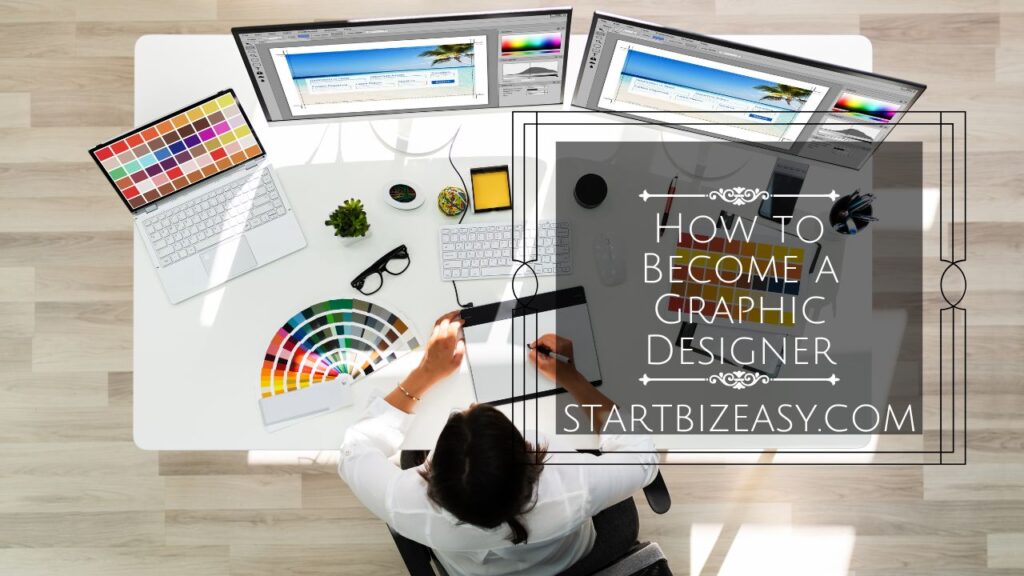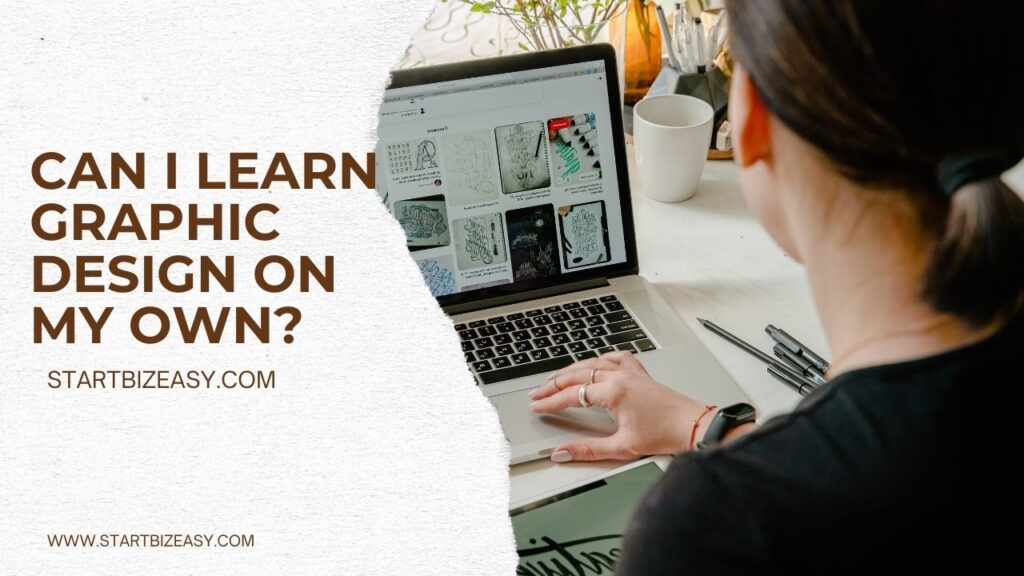
A graphic designer is a creative professional who combines art and technology to visually communicate ideas. They use different design elements like images, typography, colors, and layout techniques to create visual concepts that convey messages or evoke specific emotions.
Graphic designers work on various projects such as advertisements, branding, packaging, websites, magazines, and more. They often collaborate with clients or art directors to understand their needs and create designs that meet their objectives.
To create their designs, graphic designers typically use software such as Adobe Photoshop, Illustrator, and InDesign. They also need to stay updated on design trends, software tools, and techniques to produce effective and visually appealing designs.
In Nigeria, the average salary for a graphic designer ranges from NGN 50,000 to NGN 150,000 per month.
Here is how you can become a graphic designer.
Table of Contents
1. Education and Training:
If you’re aspiring to become a graphic designer, one of the primary steps is to invest in education and training. Considering formal education in graphic design or a related field can provide you with a solid foundation to kickstart your career.
Numerous universities, colleges, and art schools offer degree programs or courses specifically tailored to graphic design. These programs typically cover essential design principles, techniques, and software proficiency necessary for the profession.
Additionally, online courses and tutorials have become increasingly popular and valuable resources for learning graphic design. These platforms offer flexibility and accessibility, allowing individuals to learn at their own pace and from anywhere with an internet connection.
Online platforms such as Coursera, Udemy, Skillshare, Adobe Creative Cloud Tutorials, YouTube, and LinkedIn Learning offer a wide range of courses covering various aspects of graphic design, from beginner to advanced levels.
Online courses often cover a wide range of topics, from basic design fundamentals to advanced techniques, and can be an excellent supplement to formal education or a viable alternative for those unable to attend traditional institutions.
Overall, becoming proficient in graphic design can take anywhere from 1 to 3 years or more, depending on your prior experience, learning pace, and level of commitment. It’s important to remember that learning graphic design is an ongoing process, and continual practice and learning are key to mastering the craft.
Whether through traditional education or online learning, acquiring knowledge and skills in graphic design is crucial for preparing yourself for the demands of the profession. By investing in education and training, you can lay a strong foundation and equip yourself with the tools necessary to succeed as a graphic designer.
2. Develop Your Design Skills:
To excel as a graphic designer, it’s essential to continuously refine and improve your design skills. One of the most effective ways to do this is by dedicating time to regular practice and experimentation. Challenge yourself to try out different techniques, styles, and mediums to expand your creative repertoire and develop your unique design aesthetic.
Study design fundamentals such as composition, typography, color theory, and visual hierarchy to deepen your understanding of how to create visually compelling and effective designs. By mastering these principles, you’ll be better equipped to craft designs that communicate messages clearly and resonate with your audience.
It’s also crucial to stay abreast of current design trends and emerging technologies within the industry. Design trends evolve rapidly, and staying informed allows you to adapt your work to meet the changing preferences of clients and audiences. Embrace new tools and technologies that can streamline your workflow and enhance your design capabilities, ensuring that you remain competitive in the ever-evolving field of graphic design.
Programs like Adobe Creative Suite, which includes Photoshop, Illustrator, and InDesign, are industry-standard tools used by graphic designers worldwide. By becoming proficient in these software applications, you can effectively execute your design ideas and bring them to life.
By focusing on honing your design skills through regular practice, studying fundamental principles, and staying updated on industry trends, you’ll be well-positioned to create compelling and impactful designs that set you apart as a skilled graphic designer.
3. Gain Experience:
Building practical experience is crucial for aspiring graphic designers. Seek opportunities to apply your skills in real-world settings through internships, freelance projects, or part-time positions. These experiences provide invaluable hands-on learning opportunities and allow you to demonstrate your capabilities in a professional context.
Working on real-world design projects exposes you to the challenges and dynamics of the industry, helping you develop problem-solving skills and gain insights into client expectations. Collaborating with clients or colleagues fosters communication and teamwork skills, essential for navigating the collaborative nature of graphic design work.
Additionally, each project you undertake offers a chance to refine your craft and expand your portfolio. As you complete projects, collect samples of your work to showcase your abilities to potential employers or clients. A diverse portfolio that demonstrates your range of skills and styles can significantly enhance your prospects in the competitive field of graphic design.
Embrace feedback from clients, colleagues, or mentors and use it as an opportunity for growth and improvement. Constructive criticism helps you identify areas for development and refine your design approach. By continually learning from each project and striving for improvement, you’ll enhance your skills and confidence as a graphic designer.
4. Build Your Portfolio:
Creating a strong portfolio is essential for showcasing your talents and securing opportunities as a graphic designer. Your portfolio should feature a curated selection of your best work, highlighting your skills and versatility across different design mediums and projects.
Include a diverse range of pieces in your portfolio, such as logos, branding materials, print collateral, web design, and digital illustrations. By showcasing a variety of projects, you demonstrate your ability to adapt to different design challenges and cater to various client needs.
Each piece in your portfolio should be carefully selected to showcase your proficiency in design principles, creativity, and attention to detail. Aim to include projects that highlight your unique style and approach while also demonstrating your ability to meet client objectives effectively.
Your portfolio serves as a visual representation of your skills and creativity, making it essential for making a strong impression on potential employers or clients. Ensure that your portfolio is well-organized, easy to navigate, and professionally presented to leave a lasting impact on viewers.
Regularly update your portfolio with new projects and refine it based on feedback and evolving design trends. By continuously improving and expanding your portfolio, you’ll enhance your chances of success as a graphic designer and attract opportunities for career advancement.
5. Job Search and Career Growth:
Navigating the job market and fostering career growth as a graphic designer involves several essential steps. Firstly, it’s crucial to explore job opportunities across various industries such as advertising, marketing, publishing, and digital media. Each sector offers unique avenues for creative expression and professional development.
To find job openings, utilize online resources such as job boards (like Indeed, Glassdoor, Monster, and SimplyHired), professional networking platforms like LinkedIn, and specialized design websites (such as Dribbble, Behance, and Creativepool). These platforms provide access to a wide range of opportunities and allow you to filter based on your preferences and qualifications.
When applying for positions, tailor your resume and portfolio to each job opportunity. Highlight relevant experience, skills, and achievements that align with the specific requirements of the role. Customizing your application materials demonstrates your understanding of the job and increases your chances of standing out to potential employers.
As you gain experience in the field, consider avenues for career advancement such as promotions, specialized roles, or freelance opportunities. Continuously seek opportunities for professional development and skill enhancement to remain competitive. Networking with industry professionals and seeking mentorship can also open doors to new career opportunities and growth.
6. Networking and Professional Development:
Networking and professional development are essential components of a successful career in graphic design. By actively engaging with your professional community, you can unlock opportunities for growth and advancement.
Networking involves building connections with fellow designers, industry professionals, and potential clients. Attend design events, workshops, and conferences to meet like-minded individuals and forge valuable relationships. These connections can lead to collaboration opportunities, job referrals, and valuable insights into industry trends.
Staying informed about industry developments is crucial for staying competitive. By participating in design-related activities and discussions, you can stay up-to-date with the latest trends, technologies, and best practices. This knowledge not only informs your work but also positions you as a knowledgeable and valuable asset in the field.
Engaging online is another important aspect of professional development. Participate in online design communities, forums, and social media platforms to connect with peers and share your work. This exposure can lead to new opportunities and collaborations while allowing you to establish yourself as a credible voice within the design community.
Seeking mentorship from experienced professionals can provide invaluable guidance and support as you navigate your career. A mentor can offer insights, advice, and constructive feedback to help you overcome challenges and reach your goals more efficiently.
By actively networking, staying informed, engaging online, and seeking mentorship, you can continually develop your skills, expand your opportunities, and advance your career in graphic design.
Types of Graphic Design
Graphic design encompasses a diverse range of specialties and disciplines. Here are some common types of graphic design:
- Visual Identity/Graphics: Also known as branding design, this type of graphic design focuses on creating visual elements that represent a company or organization, including logos, color palettes, typography, and brand guidelines.
- Marketing and Advertising: Graphic designers in this field create visual assets for marketing and advertising campaigns, such as posters, banners, flyers, social media graphics, and advertisements for print and digital platforms.
- Publication Design: Publication designers work on the layout and design of printed materials such as books, magazines, newspapers, and newsletters. They are responsible for arranging text, images, and other visual elements in an engaging and readable format.
- Packaging Design: Packaging designers specialize in creating the visual appearance of product packaging, including labels, boxes, bags, and containers. They consider factors such as brand identity, product information, and shelf appeal when designing packaging.
- UI/UX Design: User interface (UI) and user experience (UX) designers focus on creating digital interfaces that are intuitive, functional, and visually appealing. They design websites, mobile apps, and other interactive platforms with the user’s experience in mind.
- Motion Graphics: Motion graphic designers create animated visual content for videos, commercials, presentations, and other multimedia projects. They combine graphic design elements with animation techniques to convey messages and tell stories.
- Environmental/Experiential Design: Environmental designers create visual elements for physical spaces, such as signage, wayfinding systems, and environmental graphics for retail stores, museums, exhibitions, and events.
- Illustration: Illustrators use drawing and painting techniques to create visual representations of ideas, concepts, or narratives. They may work on book illustrations, editorial illustrations, infographics, or digital illustrations for various purposes.
- Web Design: Web designers specialize in creating the visual appearance and layout of websites. They design web pages, user interfaces, and navigation systems to optimize the user experience and achieve the website’s objectives.
- Typography/Typography Design: Typography designers focus on the art and technique of arranging typefaces to make written language readable and visually appealing. They may create custom fonts, design typographic posters, or work on editorial layouts where typography plays a prominent role.
These are just a few examples of the diverse range of graphic design specialties, each requiring different skills, techniques, and creative approaches.
Free and Paid AI Tools for Graphic Design

An AI tool for graphic design is a software application that utilizes artificial intelligence algorithms to assist designers in various aspects of the design process.
There are several AI tools available for graphic design that can streamline workflows, automate repetitive tasks, and enhance creativity. Some popular AI-powered tools for graphic design include:
- Adobe Sensei: Adobe Sensei is an AI-powered platform integrated into Adobe Creative Cloud applications such as Photoshop, Illustrator, and InDesign. It offers features like content-aware fill, object selection, and font recognition to enhance productivity and creativity.
- Canva: Canva is a popular online graphic design platform that incorporates AI technology to simplify the design process. It offers design templates, photo editing tools, and a drag-and-drop interface, making it accessible to users with varying levels of design experience.
- Designhill’s AI Logo Maker: Designhill’s AI Logo Maker is a tool that uses artificial intelligence to generate logo designs based on user preferences and inputs. It offers customizable templates and allows users to experiment with different design elements to create a unique logo for their brand.
- RunwayML: RunwayML is a machine learning toolkit that enables designers to experiment with AI-generated content and integrate machine learning models into their creative projects. It provides access to pre-trained models for tasks like image generation, style transfer, and object detection.
- Figma’s Auto Layout: Figma is a collaborative design tool that includes Auto Layout functionality powered by AI. Auto Layout simplifies the process of designing responsive user interfaces by automatically adjusting layout elements based on content changes and screen sizes.
- DesignScape by PicsArt: DesignScape is an AI-powered design tool that offers advanced editing features, filters, and effects to enhance photos and create graphic designs. It provides intelligent object removal, background replacement, and artistic filters to transform images and designs.
- Stencil: Stencil is a graphic design tool that uses AI to assist with tasks such as resizing images for various social media platforms, generating color palettes, and suggesting font combinations. It helps designers optimize their designs for different contexts and platforms.
- Artificial Intelligence for Image Enhancement (AIE): AIE is a collection of AI-powered tools developed by various companies such as Topaz Labs and Skylum. These tools use machine learning algorithms to enhance image quality, remove noise, and apply artistic effects automatically.
- Logojoy: Logojoy is an AI-driven logo design tool that generates custom logo designs based on user preferences and input. It uses machine learning algorithms to analyze design trends and create visually appealing logos tailored to individual businesses or brands.
- Artboard Studio: Artboard Studio offers a browser-based platform for creating mockups and product presentations. Its AI-powered features assist in generating realistic mockups by automatically adjusting shadows, reflections, and perspectives based on user inputs.
These AI tools for graphic design empower designers to work more efficiently, explore new creative possibilities, and deliver high-quality designs in less time.
Where to find Graphic Design Internship Remotely
Finding remote graphic design internships can be facilitated through various online platforms and resources:
- Internship Websites: Websites like Internships.com, Indeed, Glassdoor, and Internshala often list remote internship opportunities across various industries, including graphic design. You can use search filters to specify your preferences for remote positions.
- Company Websites: Explore the career or internship sections of companies that offer remote work options. Many companies, including design agencies, tech startups, and digital marketing firms, may offer remote internships for graphic design roles. Check their websites regularly for updates on internship openings.
- Freelance Platforms: Freelance platforms such as Upwork, Freelancer, and Fiverr occasionally feature internship opportunities for graphic designers. While not traditional internships, these platforms can provide valuable hands-on experience and networking opportunities in a remote setting.
- Online Design Communities: Join online design communities and forums like Dribbble, Behance, and Reddit’s r/design_critiques. These platforms often have sections dedicated to job postings and internship opportunities, including remote positions.
- Social Media: Follow companies, design agencies, and industry professionals on social media platforms like LinkedIn, X, and Instagram. They may share announcements about remote internship opportunities or post openings directly on their profiles.
- Networking: Utilize your professional network to inquire about remote internship opportunities. Reach out to professors, classmates, mentors, and industry contacts to see if they know of any available positions or can provide referrals to companies offering remote internships.
By leveraging these resources and actively searching for remote graphic design internships, you can increase your chances of finding valuable opportunities to gain experience and develop your skills in a remote work environment.
How to do Graphic Design on Laptop
To start doing graphic design on your laptop, you’ll need the right software and some creativity. Here’s how you can get started:
First, choose the graphic design software that suits your needs. Adobe Creative Cloud offers a comprehensive suite of tools including Photoshop for image editing, Illustrator for vector graphics, and InDesign for layout design. Other options like Affinity Designer and Canva are also popular choices.
Once you’ve decided on your software, download and install it on your laptop. Follow the instructions provided by the software provider to complete the installation process.
Next, familiarize yourself with the software. Take some time to explore its features and functionalities. You can find tutorials and guides online to help you learn the basics of the software and get started with your first project.
Gather the resources you’ll need for your design projects. This may include images, graphics, fonts, and other assets. You can find free resources online through websites like Unsplash and Google Fonts, or purchase premium resources from stock image and font websites.
Now it’s time to start designing! Open your graphic design software and begin your project. Whether you’re creating a logo, poster, website, or other design, use the tools and features available to bring your ideas to life. Don’t be afraid to experiment with different techniques and styles to achieve the look you want.
As you work on your designs, remember to save your progress regularly to avoid losing your work. Save your files in a format compatible with your software and consider creating backups to prevent data loss.
Once you’ve completed your design, seek feedback from others to help you improve. Share your work with peers, mentors, or clients and listen to their suggestions for refinement.
Finally, when your design is ready, export it in the appropriate format for its intended use. For example, save print designs as high-resolution PDFs and web graphics as JPEGs or PNGs. Pay attention to resolution, color mode, and file size to ensure optimal quality.
Can I do Graphic Design on my Phone?
Absolutely! You can definitely do graphic design on your phone. Thanks to the advancements in mobile technology and the availability of powerful graphic design apps, creating stunning visuals right from your smartphone is entirely feasible.
Graphic design apps like Adobe Photoshop Express, Adobe Illustrator Draw, Canva, Procreate Pocket, and Affinity Designer for iPad offer a wide range of features and functionalities. These apps enable you to create and edit images, illustrations, and designs directly on your phone.
The touchscreen capabilities of smartphones make interaction with design elements intuitive. You can use gestures like tapping, dragging, pinching, and swiping to manipulate objects, draw shapes, apply effects, and more, allowing for precise and creative design work.
One of the key advantages of designing on a phone is portability. Whether you’re commuting, traveling, or relaxing at home, you can access your design tools and work on projects without being tied to a desktop computer or laptop.
Moreover, many graphic design apps offer cloud integration, allowing you to sync your work across multiple devices. This means you can start a design on your phone and seamlessly continue working on it later on your tablet or computer, ensuring flexibility and continuity in your workflow.
Additionally, these apps often provide a variety of templates, graphics, fonts, and other resources to help you get started with your projects. This makes it easier to create professional-looking visuals even when working on a smaller screen.
While designing on a phone may have some limitations compared to working on a larger screen with desktop software, modern smartphones are powerful devices capable of handling a wide range of graphic design tasks. With the right apps and creativity, you can produce impressive designs right from the palm of your hand.
Can I learn Graphic Design on my own?

Absolutely, you can learn graphic design on your own. Many successful designers have taken this path, driven by curiosity and passion for the craft.
Start by immersing yourself in the abundant online resources available. Websites like Skillshare, YouTube tutorials, and design blogs offer a treasure trove of information, from basic principles to advanced techniques.
Books are another invaluable resource. Explore titles by respected designers and educators to deepen your understanding of design theory and practice.
But don’t just consume information—put it into practice. Dedicate time to regular practice, experimenting with different tools, styles, and projects. The more you practice, the more your skills will grow.
Seek feedback on your work from peers, mentors, or online communities. Constructive criticism can provide valuable insights and help you refine your skills.
Analyzing existing designs can also be instructive. Study designs you admire, dissecting them to understand their composition, use of color, typography, and other elements.
As you gain confidence and skill, start building a portfolio showcasing your best work. Your portfolio is your calling card, demonstrating your abilities to potential clients or employers.
Remember, learning graphic design is an ongoing journey. Stay curious, keep learning, and don’t be afraid to challenge yourself with new projects and techniques. With dedication and perseverance, you can develop the skills and expertise to thrive in the world of graphic design.
The Highest Paid Graphic Design Jobs
The highest-paid graphic design jobs often involve specialized skills and expertise, as well as experience in demanding industries. Here are a few examples:
- Creative Director: Creative directors oversee the visual aspects of projects, leading design teams and ensuring creative excellence. They often have extensive experience in the field and are responsible for setting the overall artistic direction and vision for projects. Creative directors typically earn high salaries due to their leadership role and level of responsibility. The average salary for creative directors typically ranges from $80,000 to $200,000 per year, with top earners in large agencies or corporations potentially earning even more, particularly in major metropolitan areas.
- Art Director: Art directors are responsible for the visual style and imagery used in advertising, marketing campaigns, and other creative projects. They work closely with clients, designers, and other stakeholders to develop concepts and execute designs that meet project objectives. Art directors with experience and a strong portfolio command high salaries in the industry. Art directors can expect to earn an average salary ranging from $60,000 to $150,000 per year, depending on factors such as experience, location, and industry. Those working in advertising, marketing, or media tend to earn higher salaries.
- Brand Identity Designer: Brand identity designers specialize in creating visual identities for companies, including logos, branding materials, and style guides. They play a crucial role in shaping a brand’s image and perception in the market. Brand identity designers who work with high-profile clients or established brands often earn substantial incomes. The average salary for brand identity designers ranges from $50,000 to $120,000 per year. Salary can vary based on factors such as the designer’s level of experience, the complexity of projects, and the reputation of the clients or agencies they work with.
- User Experience (UX) Designer: UX designers focus on creating intuitive and user-friendly interfaces for websites, mobile apps, and other digital products. They conduct research, design wireframes and prototypes, and collaborate with developers to ensure a seamless user experience. Experienced UX designers with a track record of successful projects can command top salaries in the tech industry. UX designers typically earn salaries ranging from $60,000 to $140,000 per year, depending on factors such as experience, location, and industry. Professionals with advanced skills in UX research, interaction design, and prototyping may command higher salaries.
- Freelance or Independent Designer: Some graphic designers choose to work independently as freelancers, offering their services to clients on a project basis. Freelancers have the potential to earn high hourly rates or project fees, especially if they specialize in niche areas such as illustration, motion graphics, or web design. Freelance graphic designers’ earnings can vary widely based on factors such as their hourly rate, the number of clients they serve, and the demand for their services. On average, freelance graphic designers may earn anywhere from $30,000 to $100,000 or more per year, with top earners often charging higher rates for specialized services.
Overall, the highest-paid graphic design jobs often require a combination of specialized skills, experience, and a strong portfolio demonstrating creative excellence and success in the field. Additionally, working in industries such as advertising, marketing, technology, and entertainment can offer lucrative opportunities for graphic designers.
Can I learn Graphic Design with no experience?
Absolutely! You can certainly learn graphic design without any prior experience. Many successful designers have started from scratch and developed their skills through dedication and practice.
Begin by immersing yourself in the world of graphic design. Explore online resources, tutorials, and courses that cover the fundamentals of design principles, typography, color theory, and layout composition.
Experimentation is key. Start playing around with design software like Adobe Photoshop, Illustrator, or InDesign. While it may seem daunting at first, don’t be afraid to dive in and explore the tools and features. Practice regularly to become familiar with the software and develop your skills.
Seek feedback from others to help you improve. Share your work with peers, mentors, or online communities and be open to constructive criticism. Feedback can provide valuable insights and perspectives that will help you grow as a designer.
Study design theory to understand the underlying principles behind effective design. Analyze designs you admire and try to understand what makes them successful. Developing a critical eye for design will allow you to create more impactful and visually appealing work.
As you gain experience, start building a portfolio showcasing your best work. Your portfolio is your calling card and will demonstrate your skills and creativity to potential clients or employers.
Remember, learning graphic design is a journey that requires patience, perseverance, and a willingness to learn. Embrace the process, stay curious, and keep pushing yourself to improve. With dedication and practice, you can develop the skills needed to succeed as a graphic designer, even without any prior experience.
Recommended Articles:
- How to Become a Web Developer in Just 6 Months!: Insider Tips to Accelerate Your Web Development Journey
- How to Become an Affiliate Marketer: Step-by-Step Guide for Success
- How to Easily Become a Successful Content Creator from Beginner to Pro
- How to Become a Freelancer: Step-by-Step Guide to Joining the Gig Economy
- 7 Best Online business that pays daily (Highest Paying)
Discover more from StartBizEasy
Subscribe to get the latest posts to your email.





